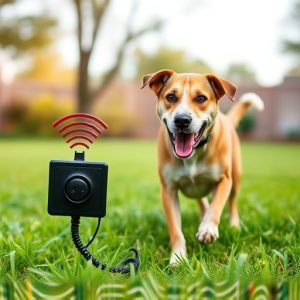Ultrasonic Bark Prevention Devices: Effective Solutions for Large Dogs
Barking issues among large dogs can be effectively managed with ultrasonic repelents, which emit ina…….
Barking issues among large dogs can be effectively managed with ultrasonic repelents, which emit inaudible yet irritating high-frequency sound waves. These devices, tailored to the specific needs of larger breeds, utilize sensitive sensors and targeted training to encourage quiet behavior without causing harm. By acclimatizing dogs to the sound range and combining it with positive reinforcement, these tools can significantly reduce unwanted barking over time. Their use in urban settings has proven successful, fostering quieter neighborhoods and improving the lives of both pets and their owners while strengthening the human-animal bond.
“Discover the revolutionary power of Bark Prevention Electronic Handheld Devices – a game-changer in pet training. This comprehensive guide explores how these innovative tools use ultrasonic repellents to curb excessive barking, offering a non-violent solution tailored for large dogs. From understanding the technology’s mechanics to selecting the ideal device and practical tips for implementation, we cover all aspects. Read on to explore real-world success stories and gain insights into effectively managing canine behavior with advanced ultrasonic repellent ranges.”
- Understanding Bark Prevention Devices: How Do They Work?
- The Science Behind Ultrasonic Repellents for Dogs
- Choosing the Right Device: Factors to Consider for Large Dogs
- Training and Implementation Tips for Effective Use
- Real-World Applications and Success Stories
Understanding Bark Prevention Devices: How Do They Work?
Bark prevention devices, often seen as innovative solutions for pet owners, utilize technology to address excessive barking in dogs. These devices are designed to be non-lethal and humane alternatives to traditional punishment methods. At their core, they emit sounds or signals that are unpleasant to dogs, encouraging them to stop barking. One of the most popular types is an ultrasonic repellent, which uses high-frequency sound waves beyond human hearing range but discomforting to canines. This technology is particularly effective for large dogs with a broader hearing range, offering a adjustable ultrasonic repellent range tailored to their needs.
The mechanism involves sensors that detect barking and trigger the emission of these sounds. The device can be set to specific sensitivity levels to avoid false activations and ensure it only activates when a dog barks excessively. This targeted approach allows for effective training without causing physical harm or distress to the animal. By reinforcing quiet behavior, owners can help their dogs learn appropriate vocalization, reducing unwanted barking over time.
The Science Behind Ultrasonic Repellents for Dogs
The Science Behind Ultrasonic Repellents for Dogs
Ultrasonic repellents work by emitting high-frequency sound waves that are inaudible to humans but irritating to dogs. This technology leverages a principle known as the dog’s sensitive hearing, which allows them to detect sounds beyond human perception. The ultrasonic range typically covers 25 to 64 kHz, a frequency band that is particularly offensive to canines without causing any physical harm. When an electronic handheld device emits these waves, it creates an area of discomfort for dogs, effectively deterring them from specific zones or behaviors.
For large dogs, the effectiveness of ultrasonic repellents can be enhanced by considering the ultrasonic repellent range. Devices designed for larger breeds often emit sounds at higher intensities and broader ranges to ensure they reach dogs with varied body sizes and hearing capabilities. This tailored approach ensures that the repellent remains effective even against more robust canine senses, making it a reliable tool for training and behavior modification.
Choosing the Right Device: Factors to Consider for Large Dogs
When selecting an electronic handheld device for preventing bark issues in large dogs, several key factors come into play. One of the primary considerations is the ultrasonic repellent range. For larger breeds, a device with a more extensive range can be beneficial as these canines tend to have stronger vocal cords and may be more difficult to deter with higher frequencies. The ultrasonic range should be sufficient enough to cover the dog’s usual area, ensuring consistent intervention during barking episodes.
Additionally, durability is essential. Large dogs may accidentally knock over or play roughly with the device, so a robust construction is vital. Water resistance can also be an advantage, as many electronic devices are better suited for outdoor use where moisture and rain are common.
Training and Implementation Tips for Effective Use
When introducing an ultrasonic repellent device for large dogs, proper training is key to its success. Start by acclimatizing your dog to the device’s sound range. Allow them to become comfortable with the frequency, as initial exposure might cause curiosity or mild discomfort. Use positive reinforcement techniques; reward calm behavior and ignore any reactions to ensure a positive association. Gradually increase the sensitivity settings over time, allowing your dog to adapt at their own pace.
For optimal results, implement consistent training sessions in various environments. The ultrasonic repellent’s effectiveness can be enhanced by combining it with other training methods, such as command teachings and reward-based training. Ensure regular practice to reinforce the behavior you want to see. Additionally, maintaining a consistent schedule for feeding and exercise can reduce any anxiety or restlessness that might impact your dog’s response to the device.
Real-World Applications and Success Stories
In real-world applications, electronic bark prevention devices have proven effective in various settings. One notable area is urban environments where excessive dog barking can cause disturbances. The ultrasonic repelents, designed for large dogs, emit high-frequency sound waves that are unpleasant to canines, deterring them from barking unnecessarily without causing harm. This technology has been successfully implemented in apartment complexes and public spaces, leading to quieter and more peaceful neighborhoods.
Many pet owners have also shared success stories with these devices. For families with new puppies or dogs with separation anxiety, the handheld electronic bark preventers offer a humane solution. By conditioning dogs to associate barking with an unpleasant sensation, owners can gradually reduce excessive noise without resorting to harsh punishment methods. This not only improves the quality of life for both pets and their owners but also strengthens the bond between them.
Bark prevention electronic handheld devices, particularly ultrasonic repellents, offer a humane and effective solution for managing excessive dog barking. Understanding how these devices work and the science behind their effectiveness, as well as choosing the right model for your large dog, is crucial. By following training and implementation tips, you can achieve successful results in various real-world applications. When selecting a device, consider an ultrasonic repellent with an extended ultrasonic repellent range for large dogs to ensure comprehensive coverage without causing harm or distress to your pet.


